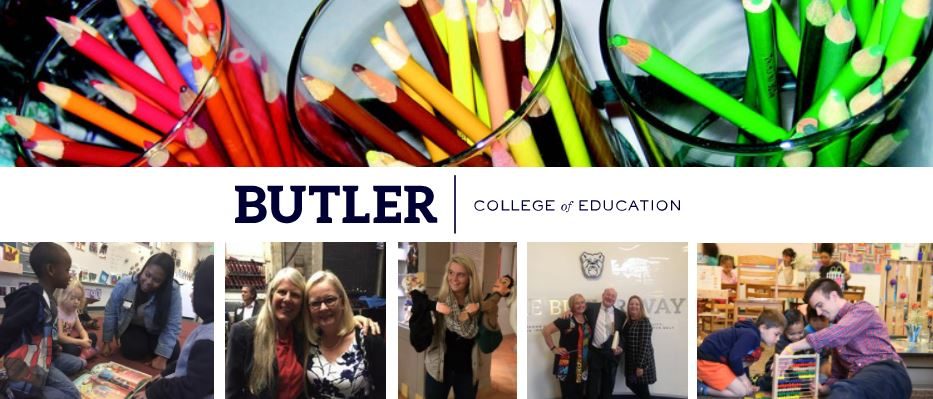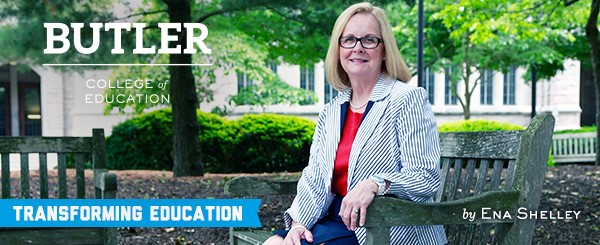Friends,
As I have mentioned before, Butler University’s College of Education was selected for recognition by the American Association of Colleges for Teacher Education (AACTE) as a “model of excellence in clinical preparation for teacher education.” AACTE came to campus and filmed our faculty, school partners, and advocates (community members, a Board of Trustees member, Board of Visitors members, and business community partners) for their Research to Practice Spotlight blog series. Over the next month, they will be releasing blog posts with video excerpts of what they filmed. Below is the first blog post:
Butler Lab School a ‘Dream Come True’ for Dean, Partners
Butler University Dean Ena Shelley and her faculty and PK-12 partners are enthusiastic when describing their Reggio Emilia lab school and the other clinical partnerships supporting their preparation of Indianapolis teachers.
“It’s a dream come true,” Shelley said of the lab school that opened in 2010 and has garnered attention from around the world (see this article, for example) for its unusual approach of applying the Reggio model, typically associated with early childhood settings, at the elementary level.
The lab school builds on years of partnership between Butler and the Indianapolis Public Schools (IPS), which continues to offer preservice teachers clinical experiences in several sites. After visiting Italy years ago, Shelley says, she was so taken with the Reggio approach that she persuaded her faculty colleagues and PK-12 partners to study it together as a learning community and decide how to move forward together. As the resulting Indianapolis Reggio Collaborative worked to build awareness of the model around the state, Shelley incorporated the project-based model in her own teaching, but she had to wait years before the right opportunity arose for setting up the lab school.
Before that happened, Shelley’s Reggio course work inspired Connie Sherman, executive director of St. Mary’s Child Center, to redesign the center’s programs around the philosophy. Eventually her preschool would have a site at the IPS/Butler Lab School, a partnership that Sherman describes as “a pretty remarkable relationship.” Not only do the student teachers become valuable members of the instructional team, she says, but they develop into such effective educators that St. Mary’s tries to keep them from leaving by hiring them whenever possible. Shortridge High School, an IB World School, is one of the College of Education’s longer-standing clinical partners in IPS. Master Practitioner Flo Barnes, who serves as a liaison in the Shortridge-Butler partnership, says teacher candidates not only provide a valuable second adult in the room but also ask questions that inspire their mentor teachers to remember and reconnect with their values. Professor Shelly Furuness explains that Butler’s mission is to “prepare candidates for schools as they should be,” and it’s powerful for mentor teachers to work next to these enthusiastic, optimistic preservice teachers. Shortridge science teacher Abby Solstis notes that one of the many benefits her high school students get from the partnership is that they work harder on presentations for the “outsiders” from Butler. What’s more, she says, “The students benefit a lot from just interacting with college students.”
Greg Nolan of IPS describes the deep student-driven learning that the Reggio “workshop” teaching method enables as well as the benefit of going to school in a PK-12 continuum that partners with a high-quality postsecondary institution. “At such a young age, to be able to interact with folks who are coaching you […] especially around what you’re going to do when you leave high school, how you view the world, your citizenship, how you approach learning in general for yourself—that’s invaluable.”
Asked for advice to others looking to develop a similar clinical partnership, Shortridge Principal Shane O’Day emphasizes the importance of constant communication to ease the pain of change and build trust around mutual ground for moving a partnership forward. “And that’s a little scary, because oftentimes our schools have been isolated in silos; our universities have been in silos. And, so, as you begin to create that partnership, you begin to make that paradigm shift of what school can—and really what it should—be.”
Watch the video interviews with these and other educators in the Butler partner network, and stay tuned for the next installments of this series!
For more information or to see additional blog posts and videos, follow us on social media or visit AACTE’s blog.
Dr. Ena Shelley
Dean, College of Education

